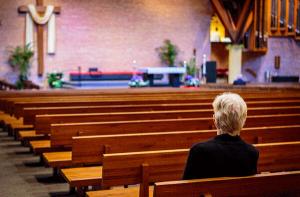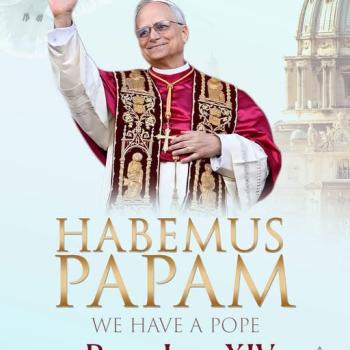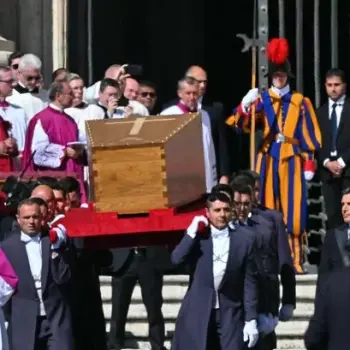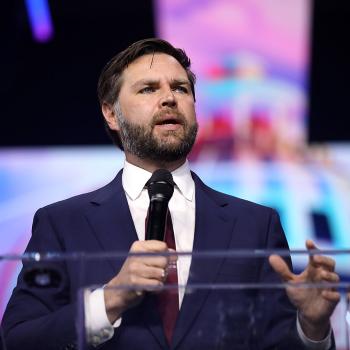
Where Are You Catholics?
A little riff on a famous Christmas song:
Where are you Catholics?
Why can’t I find you?
Why have you gone away?
Back in June 2020, I wrote an article that prophesied Catholics would not return after the pandemic. (See: www.patheos.com/blogs/ericbarr/2020/06/catholics-they-are-not-coming-back-unless/). The Church had lifted the obligation to attend Sunday Mass. Zoom Masses took the place of on site attendance. Communion services to believers who stayed in their cars–sort of like drive-in sacraments–were common. That was supposed to end when the pandemic eased, and everyone could get back to normal.
Didn’t happen.
Not surprising.
Why?
Human Nature Leading the Decline In Mass Attendance
Because people are people. They often drift to the lowest common denominator even in worship. Once a bishop lifts the obligation to go to Mass and one can miss without committing mortal sin, the human mind just doesn’t take seriously the bishop’s re-imposition of the obligation with the mortal sin penalty. A person usually says, “Last week it wasn’t a mortal sin to miss mass; this week it is–so says the bishop. I think not.” The parishioner in this anti-authoritarian age doesn’t accept that kind of episcopal authority. So, the believer exempts themselves from going to Mass.
Now, some of these actions taken by the bishops were necessary, even lifting the Sunday Mass Obligation. But none of the bishops and few pastors reckoned with human nature and put in fail-safes to help people come back. The Barna Group estimates that only 40-50% of Mass going Catholics have returned to weekly Mass (Churches changed during the pandemic and many aren’t going back – HotAir). My own unscientific perusal of my brother pastors concurs in this assessment. The die-hard believers have returned. Those only moderately attached to the parish have not. And as for those on the peripheries–they were already gone before the pandemic.
In essence, what the pandemic did was hasten the already dramatic decline in Catholic Mass Attendance that started in earnest 20 years ago, and went catastrophic beginning a decade ago. The pandemic is a dagger stabbed into the heart of Catholicism and the leaders of the Church, the doctors of the soul, bishops, priests and deacons don’t want to do the surgery necessary to save the patient. In all honesty, I really don’t think they see the danger. I believe they think things will go back to normal. But they will not. When the bubonic plague ceased its major ravaging of Europe 700 years ago, it took many decades for the Church to call back the disenchanted and skeptical people who weren’t sure religion had been very helpful during the sickness.
Catholic Secularization
Yesterday, the Pew Research Center released another of their fascinating studies on religion in the U. S. A. (About Three-in-Ten U.S. Adults Are Now Religiously Unaffiliated | Pew Research Center (pewforum.org). It showed that the secularizing trends of the past decade show no sign of stopping, but an anomaly has occurred. First of all, in 2007, religiously affiliated people outnumbered the nones (those who professed no religion) 78-16%. Today, that percentage is 63-29%. That’s a terrible decline in the practice of Christianity. Now, the anomaly occurs with Catholics. Catholics abandoning the Church had slid precipitously up until 2014 and they have held steady since at 21% of the population. That sounds like the decline has really stopped but it’s only partially good news. The statistic does not explain the absence of Catholics at Mass here in the present.
It’s bad news because the drift is real, particularly when we see that baptisms are adding numbers to the faith, so we should be growing. But it’s good news because those who have drifted away from Mass are not yet ready to put themselves in the category of “nones”. That gives Church leaders an opportunity, although a short-lived one, that needs to be taken advantage of.
Dr. Ryan Burge, political scientist at Eastern Illinois University, has written a book called The Nones: Where They Came From, Who They Are, and Where They Are Going. His studies show “Church attendance is the first thing that goes, then belonging, and finally belief—in that order,” he says. “Belief goes last.”
How The Church Is Failing And What It Must Do
- We have a belief problem that will only be partially cured by teaching correct doctrine. The right stuff has to be taught, but then it has to be experienced. This is where the b belonging piece comes in.
- New emphasis has to made on giving adults and kids experiences of God in prayer–how to recognize the presence of God, how to call on his presence throughout the day, forms of prayer that fit in with our modern experience. The rosary is a great example of this, but it must be used more flexibly and not simply related to the various Marian apparitions around the world. It is primarily a meditation on the life of Christ as seen through the eyes of the Blessed Virgin who bring Jesus to us. It is not an ideological tool.
- Priests have pressed hard on Eucharistic adoration, but, in fact, much of this labor would be better spent in creating liturgies with beautiful music where the Novus Ordo is celebrated reverently with a sense of transcendence. Focusing on Eucharistic adoration outside of Mass sounds like it would work, but it only gets the already authentic Eucharistic devotees to participate in it. Ordinary parishioners simply do not. The numbers bear this out. Eucharistic adoration needs to be done but as one piece to the puzzle of bringing a Eucharistic sense of Real Presence back to the parishioners.
- Unfortunately, home religious life has not prevailed in preserving the faith. The family as the domestic church is poverty stricken. Family rituals of prayer, even praying before meals, are routinely not done. It is rare to see families pray together, or mothers or fathers teach their children the ways of the faith. Why? Because the adults don’t know their faith or cannot translate their belief into family activities that accentuate the faith. The pandemic has shown this clearly and ripped off the mask that had everyone thinking that in this changing world the Church itself could keep its members Catholic. It cannot. Just like parents expect the schools to be the primary solvers of problems their children have, so parents expect the Church to keep their kids Catholic. Those expectations don’t work in education and they will not work in religious practice either. Without the parents being the first teachers of the faith, the Church is impotent in passing on the tradition. With a vigorous practice of family faith, the Church can do wonders. They complement one another.
These are just some thoughts to think about. The re-conversion of our absent brethren will not be easy, but it is a task we must embrace, not a burden we must bear.













